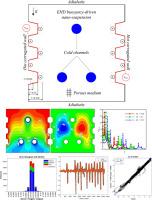利用机器学习技术模拟非线性热辐射和电场对介电纳米悬浮液热液特性的影响
IF 6.3
3区 工程技术
Q1 ENGINEERING, CHEMICAL
Journal of the Taiwan Institute of Chemical Engineers
Pub Date : 2025-06-23
DOI:10.1016/j.jtice.2025.106237
引用次数: 0
摘要
由于现代制造技术的可用性,非传统设计被发现可以提供更有效的传热。本研究使用机器学习(ML)和人工神经网络(ANN)检查波纹外壳内多孔纳米流体的流动行为。在具有三个冷却通道的介质TiO2H2O纳米液体多孔外壳内进行了电流体动力学和非线性热辐射的影响。在本文提出的ML模型中,以瑞利数、传导辐射参数、埃克特数、洛伦兹力数、电荷扩散率数、表面温度参数、达西数和沿垂直轴的域长度作为输入,而电荷密度、温度、流函数、速度和努塞尔数等与之相关的数值估定值作为ML模型的输出目标。方法采用一种强大的数值方法——有限元法(FEM),在具有通道的多孔区域内,对受非线性热辐射和EHD影响的浮力驱动电介质纳米悬浮液的控制方程(GEs)进行了无误差求解。使用基于人工神经网络的机器学习技术来确定热行为是本研究中的一种新方法。使用回归系数和均方误差等度量来衡量该方法的性能。本研究表明,随着瑞利数(Ra)的增加,传热速率增加了1.74倍,而洛伦兹力数(SE)则呈现相反的趋势。Eckert数(Ec)使Nuaveby减小13.28%。从Rd=1到Rd= 2,热辐射有效地提高了流速度31.64%。达西数(Da)的增加使水流循环增强,水流函数的大小增加了9.95%。结果表明,所使用的人工神经网络模型产生最小均方误差(MSE),具有较高的精度。研究结果有助于开发高效的传热系统,并在热交换器、电子和电池冷却系统、热力和化学工程等领域取得进展。本文章由计算机程序翻译,如有差异,请以英文原文为准。

Machine Learning technique to simulate the impact of nonlinear thermal radiation and electric field on hydrothermal features of dielectric nano-suspension
Background
Non-traditional designs were found to provide more effective heat transfer because of the availability of modern manufacturing techniques. This study examines porous nanofluid flow behavior inside a corrugated enclosure using machine learning (ML) and artificial neural networks (ANN). The influence of electrohydrodynamics (EHD) and nonlinear thermal radiation are conducted within a dielectric TiO2![]() H2O nano-liquid porous enclosure with three cooling channels. In the proposed ML model Rayleigh number, conduction-radiation parameter, Eckert number, Lorentz force number, charge diffusivity number, surface-temperature parameter, Darcy number, and domain’s length along the vertical axis are used as input, while their associated numeral estimated values of electric charge density, temperature, stream function, velocities, and Nusselt number are considered as output targets for the ML model.
H2O nano-liquid porous enclosure with three cooling channels. In the proposed ML model Rayleigh number, conduction-radiation parameter, Eckert number, Lorentz force number, charge diffusivity number, surface-temperature parameter, Darcy number, and domain’s length along the vertical axis are used as input, while their associated numeral estimated values of electric charge density, temperature, stream function, velocities, and Nusselt number are considered as output targets for the ML model.
Methods
This investigation applies one of the powerful numerical methods called the finite element method (FEM) to gain an errorless solution of governing equations (GEs) of buoyancy-driven dielectric nano-suspension in a porous domain with channels inside and influenced by non-linear thermal radiation and EHD. The use of ANN-based machine learning techniques to determine the thermal behavior is a novel approach in this study. The performance of the approach is measured using measures such as coefficient of regression and mean squared error.
Significant findings
This study shows that the rate of heat transmission increasesby 1.74 times with the rise of the Rayleigh number (Ra), while the Lorentz force number (SE) shows opposite trend. The Eckert number (Ec) reduces the Nuaveby 13.28 %. The stream velocity is effectively increased by 31.64 % by the thermal radiation while moving from Rd=1 to 2. Increasing the Darcy number (Da) enhances the flow circulation leading to a 9.95 % increase in the magnitude of stream function. Results demonstrate that the used ANN model produces minimal mean squared error (MSE) with high accuracy. The study findings contribute to the development of efficient heat transfer systems and advancements in the fields of heat exchangers, electronic and battery cooling systems, and thermal and chemical engineering.
求助全文
通过发布文献求助,成功后即可免费获取论文全文。
去求助
来源期刊
CiteScore
9.10
自引率
14.00%
发文量
362
审稿时长
35 days
期刊介绍:
Journal of the Taiwan Institute of Chemical Engineers (formerly known as Journal of the Chinese Institute of Chemical Engineers) publishes original works, from fundamental principles to practical applications, in the broad field of chemical engineering with special focus on three aspects: Chemical and Biomolecular Science and Technology, Energy and Environmental Science and Technology, and Materials Science and Technology. Authors should choose for their manuscript an appropriate aspect section and a few related classifications when submitting to the journal online.

 求助内容:
求助内容: 应助结果提醒方式:
应助结果提醒方式:


